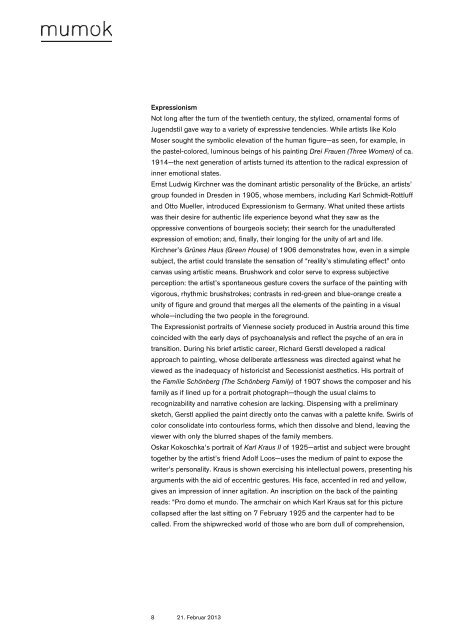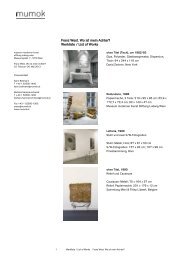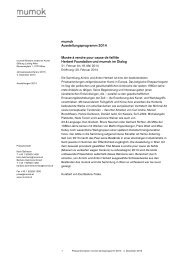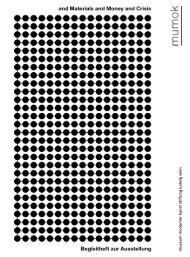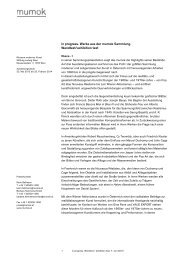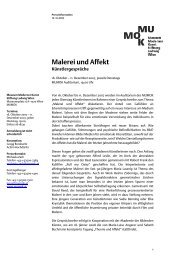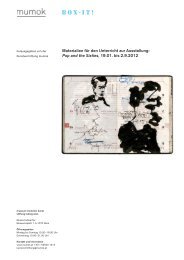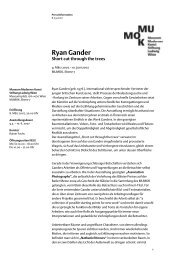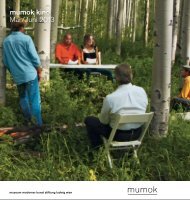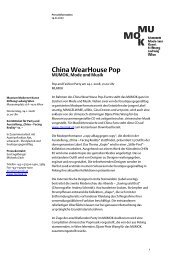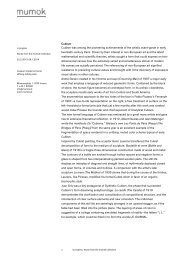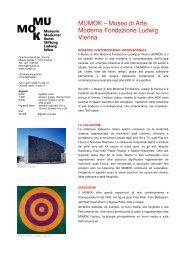in progress. Werke aus der mumok Sammlung Wandtext/exhibition text
in progress. Werke aus der mumok Sammlung Wandtext/exhibition text
in progress. Werke aus der mumok Sammlung Wandtext/exhibition text
Sie wollen auch ein ePaper? Erhöhen Sie die Reichweite Ihrer Titel.
YUMPU macht aus Druck-PDFs automatisch weboptimierte ePaper, die Google liebt.
Expressionism<br />
Not long after the turn of the twentieth century, the stylized, ornamental forms of<br />
Jugendstil gave way to a variety of expressive tendencies. While artists like Kolo<br />
Moser sought the symbolic elevation of the human figure—as seen, for example, <strong>in</strong><br />
the pastel-colored, lum<strong>in</strong>ous be<strong>in</strong>gs of his pa<strong>in</strong>t<strong>in</strong>g Drei Frauen (Three Women) of ca.<br />
1914—the next generation of artists turned its attention to the radical expression of<br />
<strong>in</strong>ner emotional states.<br />
Ernst Ludwig Kirchner was the dom<strong>in</strong>ant artistic personality of the Brücke, an artists’<br />
group founded <strong>in</strong> Dresden <strong>in</strong> 1905, whose members, <strong>in</strong>clud<strong>in</strong>g Karl Schmidt-Rottluff<br />
and Otto Mueller, <strong>in</strong>troduced Expressionism to Germany. What united these artists<br />
was their desire for authentic life experience beyond what they saw as the<br />
oppressive conventions of bourgeois society; their search for the unadulterated<br />
expression of emotion; and, f<strong>in</strong>ally, their long<strong>in</strong>g for the unity of art and life.<br />
Kirchner’s Grünes H<strong>aus</strong> (Green House) of 1906 demonstrates how, even <strong>in</strong> a simple<br />
subject, the artist could translate the sensation of “reality’s stimulat<strong>in</strong>g effect” onto<br />
canvas us<strong>in</strong>g artistic means. Brushwork and color serve to express subjective<br />
perception: the artist’s spontaneous gesture covers the surface of the pa<strong>in</strong>t<strong>in</strong>g with<br />
vigorous, rhythmic brushstrokes; contrasts <strong>in</strong> red-green and blue-orange create a<br />
unity of figure and ground that merges all the elements of the pa<strong>in</strong>t<strong>in</strong>g <strong>in</strong> a visual<br />
whole—<strong>in</strong>clud<strong>in</strong>g the two people <strong>in</strong> the foreground.<br />
The Expressionist portraits of Viennese society produced <strong>in</strong> Austria around this time<br />
co<strong>in</strong>cided with the early days of psychoanalysis and reflect the psyche of an era <strong>in</strong><br />
transition. Dur<strong>in</strong>g his brief artistic career, Richard Gerstl developed a radical<br />
approach to pa<strong>in</strong>t<strong>in</strong>g, whose deliberate artlessness was directed aga<strong>in</strong>st what he<br />
viewed as the <strong>in</strong>adequacy of historicist and Secessionist aesthetics. His portrait of<br />
the Familie Schönberg (The Schönberg Family) of 1907 shows the composer and his<br />
family as if l<strong>in</strong>ed up for a portrait photograph—though the usual claims to<br />
recognizability and narrative cohesion are lack<strong>in</strong>g. Dispens<strong>in</strong>g with a prelim<strong>in</strong>ary<br />
sketch, Gerstl applied the pa<strong>in</strong>t directly onto the canvas with a palette knife. Swirls of<br />
color consolidate <strong>in</strong>to contourless forms, which then dissolve and blend, leav<strong>in</strong>g the<br />
viewer with only the blurred shapes of the family members.<br />
Oskar Kokoschka’s portrait of Karl Kr<strong>aus</strong> II of 1925—artist and subject were brought<br />
together by the artist’s friend Adolf Loos—uses the medium of pa<strong>in</strong>t to expose the<br />
writer’s personality. Kr<strong>aus</strong> is shown exercis<strong>in</strong>g his <strong>in</strong>tellectual powers, present<strong>in</strong>g his<br />
arguments with the aid of eccentric gestures. His face, accented <strong>in</strong> red and yellow,<br />
gives an impression of <strong>in</strong>ner agitation. An <strong>in</strong>scription on the back of the pa<strong>in</strong>t<strong>in</strong>g<br />
reads: “Pro domo et mundo. The armchair on which Karl Kr<strong>aus</strong> sat for this picture<br />
collapsed after the last sitt<strong>in</strong>g on 7 February 1925 and the carpenter had to be<br />
called. From the shipwrecked world of those who are born dull of comprehension,<br />
8 21. Februar 2013


